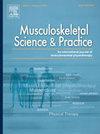Effects of combining manual therapies, neck muscle exercises, and therapeutic education pain neuroscience in patients with migraine: a 3-armed randomized clinical trial
IF 2.2
3区 医学
Q1 REHABILITATION
引用次数: 0
Abstract
Background
Physical therapy is a non-pharmacological approach for migraine management. However, the effectiveness of a multimodal approach combining manual therapies, cervical exercises, and therapeutic education, compared to these interventions individually, remains unclear.
Objectives
to investigate the effects of a multimodal approach versus manual therapies or pain neuroscience education alone in migraine patients.
Methods
A three-arm, parallel, single-blind, randomized clinical trial was conducted over 12 weeks, with assessments at baseline, 4, 8, and 12 weeks, and follow-up assessments at 1, 2, and 4 months. Seventy-five participants were randomly allocated to the Therapeutic Education Pain Neuroscience Group (TEG), Manual Therapies Group (MTG), or Multimodal Group (MUG). The primary outcome was the Headache Impact Test (HIT-6). Secondary outcomes included headache frequency, intensity, and duration; neck disability index (NDI); Allodynia Symptom Checklist (ASC-12); maladaptive beliefs; pain catastrophizing; quality of life; dizziness; and cervical assessments. Mixed models were analyzed in SPSS, considering group, time, and group-by-time interactions.
Results
All groups demonstrated significant HIT-6 improvement (p < 0.001). MTG showed greater improvement at week 4, while TEG surpassed MTG by week 12. At follow-up, MUG demonstrated superior reduction in headache impact. Significant group-by-time interactions favored multimodal treatment for headache frequency, intensity, neck pain, ASC-12, NDI, quality of life, and Flexion Rotation Test (p < 0.01). Also, MUG showed clinically relevant changes in NDI, Pain Catastrophizing Scale, quality of life, ASC-12, and Tampa Scale for Kinesiophobia.
Conclusion
Although all treatments were effective, MUG was superior in sustaining reductions in headache impact at follow-up, and improving psychosocial, headache and neck-related outcomes.
联合手工疗法、颈部肌肉锻炼和治疗性教育疼痛神经科学对偏头痛患者的影响:一项3组随机临床试验
物理治疗是治疗偏头痛的一种非药物方法。然而,与单独的干预措施相比,结合手工治疗、宫颈锻炼和治疗性教育的多模式方法的有效性尚不清楚。目的探讨多模式治疗与手工治疗或单纯疼痛神经科学教育对偏头痛患者的影响。方法采用三臂、平行、单盲、随机临床试验,为期12周,分别在基线、4周、8周和12周进行评估,在1、2和4个月进行随访评估。75名参与者被随机分配到治疗性教育疼痛神经科学组(TEG)、手工疗法组(MTG)或多模式组(MUG)。主要结果是头痛影响试验(HIT-6)。次要结局包括头痛的频率、强度和持续时间;颈部残疾指数(NDI);异常性疼痛症状检查表(ASC-12);不适应的信念;剧烈疼痛;生活质量;头晕;还有宫颈检查。混合模型在SPSS中进行分析,考虑组、时间和组间时间的相互作用。结果各组患者HIT-6均有显著改善(p <;0.001)。MTG在第4周表现出更大的改善,而TEG在第12周超过MTG。在随访中,MUG显示出头痛影响的显著减少。在头痛频率、强度、颈部疼痛、ASC-12、NDI、生活质量和屈曲旋转试验(p <;0.01)。同时,在NDI、疼痛巨化量表、生活质量、ASC-12和坦帕运动恐惧症量表中,MUG也显示出临床相关的变化。结论尽管所有治疗方法均有效,但在随访中持续减少头痛影响,改善社会心理、头痛和颈部相关结局方面,MUG具有优势。
本文章由计算机程序翻译,如有差异,请以英文原文为准。
求助全文
约1分钟内获得全文
求助全文
来源期刊

Musculoskeletal Science and Practice
Health Professions-Physical Therapy, Sports Therapy and Rehabilitation
CiteScore
4.10
自引率
8.70%
发文量
152
审稿时长
48 days
期刊介绍:
Musculoskeletal Science & Practice, international journal of musculoskeletal physiotherapy, is a peer-reviewed international journal (previously Manual Therapy), publishing high quality original research, review and Masterclass articles that contribute to improving the clinical understanding of appropriate care processes for musculoskeletal disorders. The journal publishes articles that influence or add to the body of evidence on diagnostic and therapeutic processes, patient centered care, guidelines for musculoskeletal therapeutics and theoretical models that support developments in assessment, diagnosis, clinical reasoning and interventions.
 求助内容:
求助内容: 应助结果提醒方式:
应助结果提醒方式:


